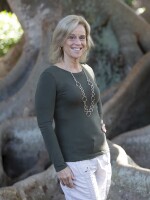How do you teach kids about ecology when the natural world is shrinking around them?
In fast growing Florida, one solution is to take environmental studies outside the walls of a classroom.
At “Nature’s Classroom” in Tampa Bay, students get a close up view of their neighboring ecosystem.
Mary Spence, a teacher at Nature's Classroom, is standing ankle deep in the Hillsborough River. She's surrounded in the water by half a dozen sixth graders awkwardly holding long handle fishing nets and looking a little confused as to what they're supposed to do with them.
"Stop right there,” she told the students. “Put the net down like this and scoop along the bottom really fast and scoop up as many leaves and twigs off the bottom as you possibly can because that's where the animals are hiding."
Nature's Classroom is a three-day immersion into the habitats surrounding the Tampa Bay watershed, and is led by Principal Barbara Mercer. Every sixth grader in Hillsborough Public Schools attends the program and private schools and charters are also welcome. In this shoreline sampling exercise, two girls emerge from the water and huddle with Spence to identify the invertebrates trapped in their net.
"Does it bite?” one asked. “No, it won't bite you, “said Spence. “You see the gills? It's like a fur coat.”
“Cool,” they exclaimed. “It’s a Mayfly Nymph,” Spence told them.
These kinds of activities show kids that an abundant biological community is one of the best indicators of a healthy river. And despite rumors of leeches in the water, the students quickly angle to snare the biggest catch. Claire Wong, a student at Terrace Community Middle School in Thonotosassa knows that the more they can find the better.
"All the creatures are all alive, they're all moving, they are all lively,” she said. “It's all good."
Before coming to this 365-acre site just northeast of Tampa, the middle schooler wasn't totally up to speed on all the species that lived in the river.
"I did not know we had water snakes or water ... things,” she said. “I thought there was only fish!"
It's no secret that children are becoming more disconnected from nature. And with around 800 new residents arriving in the state each day, many adults are also unfamiliar with native Florida wildlife. For Trea Peto of Christian Community School in Tampa, it's probably easier to recognize a corporate logo than say, a Florida Kingsnake.
"I thought it came from like Africa,” he said. “I don't know. Or like Georgia ... somewhere up there."
Many fault the decrease in outdoor time to our increasing use of electronic devices but that's just one part of a bigger picture.
Fact is, many children are no longer free to roam their neighborhoods. And those who do may not have easy access to a park or green space. According to the U.S Census Bureau, Florida has six of the nation's fastest growing urban areas.
Karen Folsom is lead teacher at Nature's Classroom. She says a lot of students have simply not grown up around nature so when they come here they don't know what to expect.
"They might have the impression that they're going to a theme park for instance,” she said. Or “that we planted everything out here. And if we see a wild animal out in the forest, the impression is that we put it there. "
That's not the way Folsom, who went to Nature's Classroom in the seventies remembers it. The program thrived until 1995 when the Hillsborough School Board closed the program because of budget cuts. It came back the very next year when community groups rallied behind it.
Bill Muncie has been teaching at Nature's Classroom for 45 years. His love of the natural world is apparent as he leads students on a boardwalk towards the property's wetlands area. He stops every few feet for a lesson, such as one on the different ways seeds can spread.
"What about a dandelion? The wind does it," he said. "Oh here's one. A bird comes along peck, peck peck, eats part of it, flies around ... poop.”
The kids thought that one was a riot. And the middle school mentality hits its mark even when the conversation turns to more serious issues like all the different ways nature is threatened. Isabel Bailey from Terrace Community School can list several.
"Global warming for example as some of us think we might be facing,” she said. “Pollution, forest fires…stuff like that."
But now that these students have made a personal connection, Muncie tells them that their job is to protect the environment.
"You're bright, you're intelligent,” he said. “Look at the shiny eyes and faces on this group. How many are going to fix it?"
A dozen hands raise and the group treks forward into the woods, passing two white tailed deer on their way.














